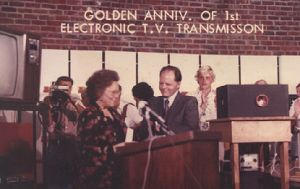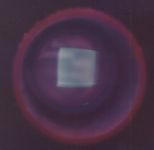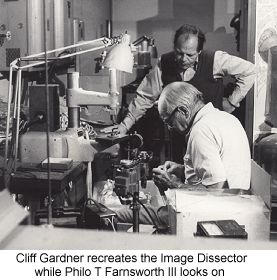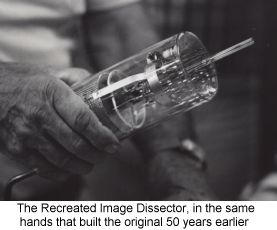Restoring Philo's Place in HistoryChallenges to the Corporate Mythtext by Nick DeMartinoPhotos by Georja Skinner.
Visit the Video Library to view other footage of this historic event |
| (The following story appeared along with the final installment of the original Farnsworth text, and was written by Nick DeMartino, publisher of TELEVISIONS, the magazine that first published the material in 1977. The text is extensively annotated with links to footnotes and back to the main text ) "There are three languages in which you can talk factually about
television," explained a Fortune Magazine article on the
eve of (RCA President) David Sarnoff's 1939 World's Fair spectacle.
"The mathematical slang of the research laboratory, the manicdepressive
jargon of Wall Street, and the jitterbug double talk of Variety."(1)
Today we can add the selfserving pieties of corporate public
relations to the languages creating the historical record. As
eyewitnesses from TV's infancy age and die, the record, with all
its inaccuracies, is in danger of becoming permanent.
As Philo's wife Pem Farnsworth observes, "When you want to
know about TV, you eventually go to RCA." The record as written
by RCA is easily accessible, and largely presumed to be authoritative.
The problem is that RCA's claim to have invented TV is based on
a technicality.
It is a simple question of patents. Every patent bears two dates-the
date of filing and the date of issue. History records the patent
at its date of filing, regardless of when a ruling on the patent
is issued.
Philo T. Farnsworth won every single challenge launched against
his patent claims by Sarnoff. Sarnoff, as a result, was forced
to pay Farnsworth royalties.
With the help of RCA publicists, Zworykin bolstered his fragile
claim. Still living, (in 1977) still giving interviews and writing
articles,(2) Zworykin is the beneficiary
of a generation of RCA PR. flacks who believed, and perpetuated,
the myth which has served RCA so well.
By the time that Farnsworth intimate George Everson's biography,
The Story of Te/evision,(3)
appeared in 1949, Philo himself was long removed from direct
involvement with his own invention. The company that bore his
name had been absorbed into International Telephone and Telegraph.
Perhaps Pem Farnsworth is right when she predicts that "Phil's
original mathematics will vindicate his place in history. He could
see what was underlying the world. Like Einstein, he crossed another
threshold, he spoke another language."
That 1977 was, in fact, the 50th anniversary of electronic television
has been shown by Paul Schatzkin in the four part series which
concludes in this issue of TELEVISIONS. Other dates and
other names have been recorded, but the truth is that the electronic
TV system we us today was not demonstrated until Sept 7, 1927,
in that loft at 202 Green Street San Francisco.
The historical record, on the other hand, tells another story.
The most recent edition of Encyclopedia Britannica, for
instance, describes Farnsworth simply as "United States engineer."
RCA's Vladimir Zworykin gets several inches in which he is crowned
"the father of television." For her part, Philo's widow, Pem, has undertaken the task of writing the definitive biography. "It was 1939 when I told Phil I was going to write his biography," recounts Pem. She was mindful at the time of her husband's lack of interest in selfpromotion, and so began amassing documents and lab notes. Most were destroyed in a fire in 1947. Over the years Pem has managed with the help of the oldest of their three sons, Philo III, to relocate most of the documents. Since then, with hours of interviews and research completed, Mrs. Farnsworth is writing the book she hopes to complete this year-the book which should set the record straight. The New York Times obituary in 1971 gave Philo sole credit for television's invention. But scores of other sources either ignore him entirely or give him second or cobilling with Zworykin, Baird or the others who worked on elements of television systems in the 20s (4). All manner of print has been manufactured which depicts for posterity a distorted view of Philo's role.(5)
When we called Les Brown, author of the justpublished NY
Times Encyclopedia of Television, he said that entries on Zworykin
and Farnsworth containing errors were contributed by an associate.
Brown said he has little expertise in the technical side of TV,
and even less interest in resolving a dispute between Farnsworth
and his competitors. (6) Farnsworth finds friends Meanwhile, more people continue to join the fight that Pem Farnsworth leads. A University of Illinois graduate student named Steve Hofer has been working on a Ph.D. dissertation on Philo's accomplishments. TV historian Al Abramson, whose new book will cover this period, has been approached with the facts by Mrs. Farnsworth.. A cousin who works for the World Book Encyclopedia is tryi ng to change the inaccurate entries in that publication .(7) Paul Schatzkin first heard of Philo in 1973. He had seen an issue of Radical Software (8) featuring an elegy by Max Crosley, a Farnsworth relative. "The Electromagnetic Spectrum Blues," painted in florid verse the tragic victimization of the genius inventor. Shortly thereafter Schatzkin discovered George Everson's biography of Farnsworth. The book transformed his life and that of (future ex-wife) Georia Skinner, a sound recordist for Norman Lear sitcoms. Schatzkin, who worked at a commercial video house called Videography, convinced his boss, Bob Kiger, to get involved. The two formed a partnership to develop the Philo story into a made-forTV movie. The first step was to buy the rights to Everson's book. They travailed to Gualala, on the Mendocino coast north of San Francisco to meet the 93yearold Farnsworth associate and offered a modest sum for the movie option. They got something even more valuable-an introduction to Pem Farnsworth, who agreed to discuss rights to the book which she and her son, Philo III, were developing. By December 1975 a deal was made and the team began developing a treatment for the movie script. The plan was to air the program on Sept. 7,1977, the 50th anniversary date. In the process of trying to sell the idea, the two enlisted more allies in the struggle to restore Philo's good name. Columnists Richard Hack, of the Hollywood Reporter and Terence O'Flaherty of the San Francisco Chronicle,(9) ran stories on Sept. 7, 1976, in support of Philo. One response to Schatzkin's attempt to interest the TV networks in Philo's story illustrates the resistance there is to restoring credit to Farnsworth. "Although television itself is of paramount interest to all of us," wrote a functionary at CBS, "it is my feeling that this alone does not make the life of the man who invented television necessarily of dramatic interest. His trials and tribulations on the way to fame and fortune are familiar to the American success story and so too his ultimate rejection of the fruits of his own invention....lt is rare when a true life story has the appropriate ingredients so it plays out less as biography and more like a movie." Shortly thereafter the TELEVISIONS series began. The partnership with Kiger had dissolved, and Schatzkin, by now a videotape editor for the Barney Miller TV show, realized that he and Skinner had neither the time nor the experience to successfully develop a TVmovie script. Recreating the past Their priority became the plan, spearheaded by Philo's oldest son, an inventor himself who lives in Bolinas, California, to create a media event on Sept. 7, 1977. Their intent was to recreate the actual demonstration that ushered in the TV age. By summer the services of a Hollywood PR man, Bob Garon, were enlisted to make contacts in the media world. One aspect of the campaign was to convince the newly reorganized Academy of Television Arts and Sciences to award a special Emmy to Philo on the Sept. 11 telecast, just four days after the 50th anniversary celebration that was being planned. At the Sept. 1 Board meeting of the Academy the proposal was voted down. The fact that many of the Academy's 20member board, including president Larry Stewart, either worked for NBC or on shows associated with NBC/RCA facilities may have had nothing to do with the decision. But, as Garon put it, "who wants to make NBC mad?" When the day arrived at the Foothill Electronics Museum near Palo Alto, not only was there a crowd of nearly 100 that included Pem, Cliff, Tobe Rutherford and others who had worked with Farnsworth, but TV crews from NBC, CBS, local San Francisco TV stations, and a number of video producers. Ironically, the NBC Nightly News carried, over the network built by RCA's David Sarnoff, news of the inventor of TV. The questions remain Why must the widow of television's inventor spend video's golden anniversary year fighting to set the record straight? The answer tells us much about the role of the independent inventor in corporate America, about the limits and rewards of "genius," and mostly about the manufacture of myth and history in a disposable culture. One reason, of course, is the man himself. Farnsworth was concerned more with his research than with exploiting the potential of his most famous invention. Unlike men like Westinghouse, Edison, Ford and Eastman, he had little enthusiasm for creating an industrial empire that could manufacture and market products from his patents, as well as propagate his legend. The man who did that, of course, was David Sarnoff, the name most closeIy associated with the marketing of television in this country. Sarnoff's realization of Farnsworth's idea was the national network we think of today as television. Philo would have been perfectly happy to allow his patents-65 when he died-to generate income from rental or license fees that could finance further research. He discovered soon just how idealistic an idea this was in the age of corporate ! sponsored, highcapital research which must first be adapted to the marketplace in order to return profits and glory to the company. Contributions to human knowledge would be mostly useful as a publicity device at some later point in the company's development. Of course, Farnsworth isn't the only inventor who has suffered such a fate. Edwin Howard Armstrong, a pioneer in radio and the inventor of FM and high fidelity, not only had his credit for certain inventions stolen, but was forced out of RCA because Sarnoff refused to develop FM radio as a competitor to AM. "Over the years Armstrong filled bulging filing cases with ietters to authors, editors and newspapers, futilely trying to keep the record straight. And not merely his own record, but that of Marconi, Fleming, Tesla and Pupin, all of whom, as independent inventors...were being subjected to the same kind of corporate devaluation. The powerful corporations by then not only wanted all the profits, but all the control and scientific credit as well " (10) Erik Barnouw, whose work credits both Armstrong and Farnsworth,(11) cites another, more blatant corporate rewrite-the General Electric TV ads featuring a kindly old Thomas Edison bestowing credit to GE company man Ernst Alexanderson that belonged to Reginald Fessenden.
By the time Farnsworth's invention came to fruition, the companies
founded upon the genius of American inventors had become huge
profit mills which strangled, not encouraged inventiveness. 
FOOTNOTES 1 - Fortune Magazine, May 1939. No author listed. (return to text) 2 - A 1962 piece in Television Quarterly (Vol. 1, No. 4), published by the TV Academy entitled "The Early Days: Some Recollections," Zworykin makes no mention at Farnsworth or any other inventors but his mentor Rosing, Dleckmann, and CampbellSwinton. In a 1976 interview he answered the question "Was there a rivalry among you?" with this: "Not in electronic television. We were not competitive in this area." (Videography, Vol. 1, No. 9) (return to text) 3 - Everson, George. The Story of Television: The Life of Philo T Farnsworth. Originally published in 1949 by W.W. Norton. Reissued in 1974 by Arno Press in its series of Telecommunications reprints edited by Christopher H. Sterling. (return to text) 4 - A good example is the July 1976 issue of the SMPTE Journal, on the occasion of the Society of Motion Pictures and Television Engineer's Own 60th anniversary. (Vol. 85, No. 7) "101 Years of Television Technology" by CBS TV's Director of Engineering Richard S. O'Brien and others. It starts with George Carey's idea for TV in 1875, marks Baird's 1925 experiments as the first practical TV demo. Baird, of course, was not working with electronic TV. In a response to Schatzkin's challenge of these facts, O'Brien lists 11 sources, most of which, he admits, "trace back to Zworykin's own statements." (return to text) 5 - The three most recent TV source books are The TV Book edited by Judy Fireman {New York: Workman Publishing Co.), Television: The First Fifty Years by Jeff Greenfield - New York: Harry N. Abrams), and The NY Times Encyclopedia of Television. All three of the books inaccurately credit Farnsworth, though the Fireman book is by far the worst. Designed as a popular catchall assembled by editor Fireman, it features contributions from a wide array of familiar and notsofamiliar TV commentators. In addition to a lulllength interview with Zworykin and only a footnotesized picture of Farnsworth, the volume sports an account of TV technology by John Taylor, a man Fireman says was referred to her by TV Radio Age as a "good popularizer." Taylor retired as an RCA VP for marketing and had spent a career flacking for Zworykin. Claimed Taylor when we called: "Farnsworth was a smart guy, but he didn't do anything to make television a business.'' (return to text) 6 - The contributing editor is David Lachenbruch of Television Digest who told us that "the record was already established when I wrote those entries," noting that "Zworykin is virtually made by RCA." (return to text) 7 - Those with contributions to make will soon have an opportunity a foundation is being established. TELEVISIONS will carry news of this soon. Meanwhile, if you have other contributions, Mrs. Farnsworth can be contacted directly at 2121 Garfield Avenue, Salt Lake City, Utah. 91808 (return to text) 8 - Gietzen, Philip, "VideoCity'' issue of Radical Software. Vol. 2 No. 3 (New York: Gordon and Breach Science Publishers. 1973). (return to text) 9 - One point O'Flaherty made in several columns was the shameful lack of even a historical plaque at 202 Green St. The oversight has been rectified by the current owners of the building, which now houses a pharmaceuticals firm. (return to text) 10 - Lessing, Lawrence. Man of High Fidelity (New York: Bantam. 1956} p. 238. (return to text) 11- Barnouw, Erik. The History or Broadcasting in the United States, Vol II: The Golden Web, pp. 3843. Also, Tube of Plenty, pp. 77 83. (Both New York: Oxford). A video account which follows the Barnouw description is Supervision: Tales of Television, produced by TVTV in episodes that followed the 1976-77 season of Visions on PBS.(return to text)
Return to: || The Farnovision || Comments? || Discussion?
� 1977, 2001Paul Schatzkin; All Rights Reserved For more information contact: The Perfesser |
 In 1977, the author of "The Farnsworth Chronicles" joined
forces with the Farnsworth family and former "lab gang" members to observe
the 50th anniversary of the first electronic video transmission, which
took place in Farnsworth's Green Street laboratory in San Francisco on
Sept 7, 1977. 50 years later, many of the people present at the original
event assembled at the Foothill Museum near Palo Alto, CA to recreate
the achievement. To make the recreation authentic, Cliff Gardner built
- from scratch and by hand - an authentic replica of the first successful
Image Dissector tube.
In 1977, the author of "The Farnsworth Chronicles" joined
forces with the Farnsworth family and former "lab gang" members to observe
the 50th anniversary of the first electronic video transmission, which
took place in Farnsworth's Green Street laboratory in San Francisco on
Sept 7, 1977. 50 years later, many of the people present at the original
event assembled at the Foothill Museum near Palo Alto, CA to recreate
the achievement. To make the recreation authentic, Cliff Gardner built
- from scratch and by hand - an authentic replica of the first successful
Image Dissector tube.  Pem herself became committed to asserting Philo's place in the history of
TV. "As time went by and RCA became more open in its claims, I became
more resolute," she says, beginning to conduct interviews with her husband
about five years before his death in 1971.
Pem herself became committed to asserting Philo's place in the history of
TV. "As time went by and RCA became more open in its claims, I became
more resolute," she says, beginning to conduct interviews with her husband
about five years before his death in 1971.  Philo III, supervised the enormous task of recreating the exact experiment
that his father's "lab gang" had demonstrated in 1927 for the Sept.
7 celebration. His uncle, Cliff Gardner and others went to the University
of California campus in Berkeley, wherethefirstglass tube had been blown 50
years earlier, to manufacture the image dissector. With elaborate care the
new lab gang, which included members of the original group and a group Philo
lil rounded up, assembled the device to make it work.
Philo III, supervised the enormous task of recreating the exact experiment
that his father's "lab gang" had demonstrated in 1927 for the Sept.
7 celebration. His uncle, Cliff Gardner and others went to the University
of California campus in Berkeley, wherethefirstglass tube had been blown 50
years earlier, to manufacture the image dissector. With elaborate care the
new lab gang, which included members of the original group and a group Philo
lil rounded up, assembled the device to make it work.
